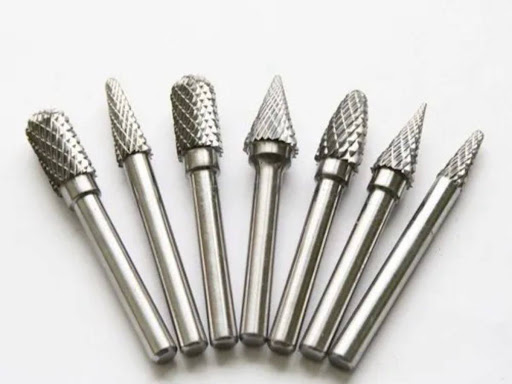A carbide burr set is a powerful tool used in various applications, from metalworking and woodworking to engraving and precision detailing. Whether you’re a professional fabricator, woodcarver, jeweler, or hobbyist, the right burrs can significantly impact your efficiency and the quality of your work.
Carbide burrs are known for their hardness, heat resistance, and durability, making them ideal for cutting, shaping, and engraving a variety of materials, including steel, aluminum, wood, plastics, stone, and even ceramics. However, not all burrs are the same. Choosing the right set depends on the type of material you’re working with, the shape of the burr, and its cut pattern.
This guide will help you understand the different types of burrs available, how to select the best burs for Dremel, carbide burr bits, and wood carving tools rotary, and how to use and maintain them properly for optimal performance.
Understanding Carbide Burrs
Carbide burrs are small but highly efficient rotary cutting tools made from tungsten carbide—a material known for its extreme hardness, second only to diamonds. These burrs are widely used in metal fabrication, jewelry making, wood carving, engraving, and even dentistry.
1. Single Cut vs. Double Cut Carbide Burrs
Carbide burrs come in two main cutting styles:
- Single Cut Burrs: These burrs have one set of spiral flutes and are designed for fast material removal. They create long chips, making them ideal for metalworking applications, such as cutting, deburring, and shaping stainless steel, cast iron, and hardened metals.
- Double Cut Burrs: These feature two intersecting sets of flutes, which cut more smoothly and produce finer chips. They are commonly used in woodworking, engraving, and working with softer metals like aluminum, brass, and copper. Double-cut burrs offer more control, reduced vibration, and a finer finish, making them ideal for precision work.
Selecting the Best Carbide Burr Set for Your Application
1. Carbide Burrs for Metalworking
For working with stainless steel, iron, aluminum, and other hard metals, choose carbide burrs that offer:
- Single-cut flutes for quick material removal.
- Cylinder burrs for smoothing and shaping flat surfaces.
- Ball-shaped burrs for creating contours and hollows.
- Flame and tree-shaped burrs for precise cutting in tight spaces.
2. Carbide Burrs for Woodworking
Woodworkers use carbide burrs for carving, detailing, and shaping wood without splintering or burning the material. The best options include:
- Double-cut burrs for precision carving and sculpting.
- Tree-shaped burrs for deep hollowing and shaping.
- Inverted cone burrs for creating undercuts and fine detailing.
- Wood carving tools rotary burrs specifically designed for softer materials.
3. Carbide Burrs for Engraving and Precision Detailing
Engraving requires delicate control and high-speed precision. The best choices for engraving include:
- Fine-grit burrs for intricate designs on metal, glass, or stone.
- Pointed burrs for deep engraving and fine linework.
- Burs for dremel tools, offering high-speed cutting and control for intricate detailing.
Choosing the Right Burr Shape
Carbide burrs come in various shapes, each suited to different tasks. Here are some common shapes and their uses:
- Cylinder Burrs: Best for flat surface grinding and edge shaping.
- Ball Burrs: Ideal for creating concave cuts and shaping rounded details.
- Oval Burrs: Used for general shaping and texturing.
- Tree Burrs: Perfect for cutting in tight corners and hard-to-reach areas.
- Inverted Cone Burrs: Great for making undercuts and V-grooves.
- Flame Burrs: Useful for precision engraving and sculpting.
Choosing the Right Shank Size
Carbide burrs are available in different shank sizes, with the most common being:
- 1/8-inch shank: Used with dremel and rotary tools for small-scale projects.
- 1/4-inch shank: Compatible with die grinders for heavy-duty applications.
- 3/32-inch shank: Found in micro-detailing burrs used for delicate engraving work.
Ensuring your burr set matches your tool’s collet size is essential for safety and proper functionality.
Tips for Proper Use and Maintenance
Using and maintaining carbide burrs correctly ensures longevity, precision, and efficiency. Here are some essential tips:
1. Use the Right Speed
Carbide burrs perform best at high speeds, typically between 15,000 to 35,000 RPM. Lower speeds can cause chatter, while excessively high speeds may lead to overheating and premature wear.
2. Apply Light Pressure
Let the burr do the cutting—excessive force can cause tool breakage or dull the flutes. Using light, consistent pressure ensures a smooth cut without damaging the burr or workpiece.
3. Clean Regularly
After use, clean your burrs with a wire brush or ultrasonic cleaner to remove debris and prevent clogging. This is especially important when working with soft materials like aluminum or wood.
4. Store Properly
Always store your carbide burr bits in a protective case to prevent chipping or dulling. Keeping them in a well-organized container ensures they remain in top condition.
5. Use Proper Cutting Techniques
- Avoid applying side pressure—carbide burrs are designed for forward motion cutting.
- Always move the burr smoothly in a circular or sweeping motion to maintain control and prevent gouging.
- When working on metal, use cutting fluid to reduce heat buildup and extend burr life.
Conclusion
Choosing the right carbide burr set depends on your specific project needs. Whether you’re working on metal, wood, or engraving delicate materials, selecting the right carbide burr bits, burs for Dremel or wood carving tools rotary ensures precision, efficiency, and long-lasting performance.



